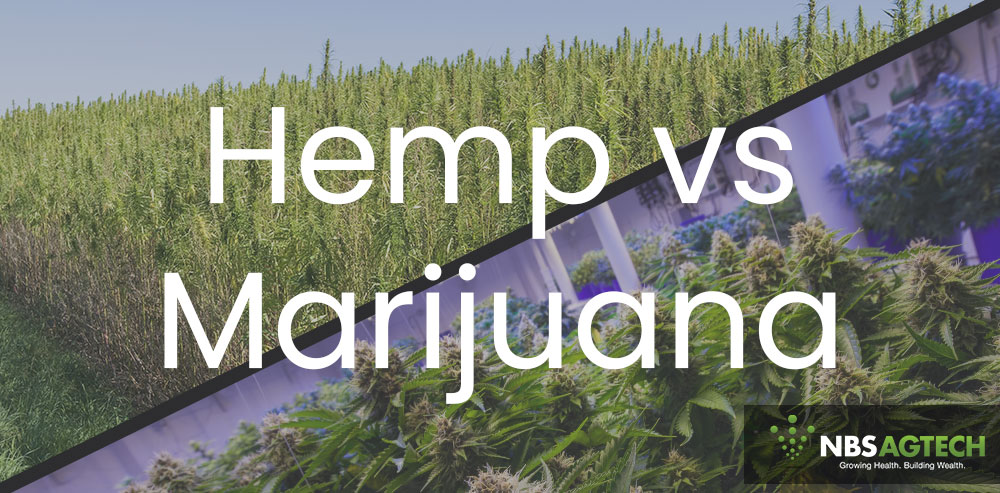
With over 500 plant families across the worldand thousands of genera, it is important to distinguish the difference between the plants one wants to farm. Even plants in the same family can require drastically different cultivation environments, have varying growth rates, chemical makeups, appearances, and uses. Although both hemp and marijuana are part of the cannabis sativa family, they vary greatly; this article will briefly outline some of the major differences between hemp vs. marijuana.
Distinguish Them by Appearance
 One of the easiest and quickest ways to tell hemp and marijuana apart is merely by how they look. Hemp and marijuana differ in appearance, both during the growth process and after cultivation. Marijuana plants, during the farming process, tend to be shorter and fatter. Hemp plants on the other hand tend to grow taller and skinnier. The leaves of a marijuana plant tend to be broader with nugget looking buds dispersed throughout, while a hemp plant has skinnier leaves that tend to accumulate at the top of a long stalk.
One of the easiest and quickest ways to tell hemp and marijuana apart is merely by how they look. Hemp and marijuana differ in appearance, both during the growth process and after cultivation. Marijuana plants, during the farming process, tend to be shorter and fatter. Hemp plants on the other hand tend to grow taller and skinnier. The leaves of a marijuana plant tend to be broader with nugget looking buds dispersed throughout, while a hemp plant has skinnier leaves that tend to accumulate at the top of a long stalk.
Chemical Makeup
One of the most drastic and most important differences between hemp and marijuana is the chemical makeup of each. This differing feature carries a lot of weight because within it resides the reason for differing legalities surrounding the cultivation of each.
While marijuana produces both tetrahydrocannabinol (THC) and cannabidiol extracts (CBD), hemp only produces CBD. Hemp plants may have trace amounts of THC in them, but it is the amount of THC present in the plant that allows it to be recognized differently than marijuana. While marijuana plants can contain anywhere from five to thirty percent THC concentrations, as long as hemp plants contain 0.3% or less of THC it can legally be classified as hemp.
The presence of THC in marijuana makes the plant psychoactive if consumed, affecting the mind. This is the major defining difference in why marijuana is more heavily regulated by the Federal Drug Administration and why some states have not legalized its cultivation or consumption. Hemp does not contain any psychoactive properties and is therefore legal to cultivate in certain states and under certain regulations, and the sale of its products are legal throughout all states in the US.
Cultivation and Uses
 Another major difference between hemp and marijuana is how the two are grown. Marijuana growers attempt to get as much space as possible between their plants, as the more water, air, and sunlight each plant gets the better for the growth and THC content. Hemp plants, on the other hand, can be placed rather close together, allowing for more plants to be cultivated in a crop space. Hemp crops are resilient and tolerant to a variety of soils, temperatures, and climates, while marijuana plants require carefully controlled climates for optimum growth.
Another major difference between hemp and marijuana is how the two are grown. Marijuana growers attempt to get as much space as possible between their plants, as the more water, air, and sunlight each plant gets the better for the growth and THC content. Hemp plants, on the other hand, can be placed rather close together, allowing for more plants to be cultivated in a crop space. Hemp crops are resilient and tolerant to a variety of soils, temperatures, and climates, while marijuana plants require carefully controlled climates for optimum growth.
Hemp can be successfully cultivated without the use of pesticides whereas marijuana plants usually experience pest problems without them. This notable difference spares hemp farmers the headache of dealing with chemical residues persisting on their crop after harvest, whereas marijuana farmers intending to sell their product for consumption are experiencing an increase in regulations and testing on their crops.
The uses for these two plants also differ greatly. Hemp plants are grown for the fiber and the seeds whereas marijuana plants are grown for the THC content. Marijuana is used mainly for medicinal or spiritual purposes while hemp may be used in the manufacturing of many products. The number of products that hemp can be used for is seemingly infinite but below is a list of a few uses, many of which may surprise you:
- Clothing
- Paper
- Canvas
- Twine
- Boat Sails
- Fishing Nets
- Pet Food
- Body Oils and Lotions
- Plastic
- Construction Materials
- Fuel
For more information on how to get your hemp farm started today email us at info@nbsagtech.com or give us a call at (702) 992 – 0552. We look forward to exploring the possibilities today of how we work together tomorrow.